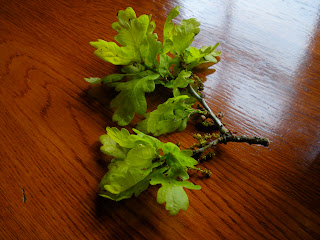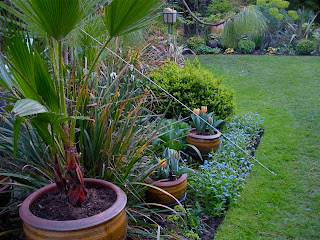Well, it means we're experiencing constant rain. As I write this, there are flood warnings right across the UK, with the worst expected to be in the South-west. It's been raining for most of April, and the rain is set to continue into May. Hmm. Funny kind of drought.
The water companies say that, despite all this precipitation, it will take more than a few weeks of rain to replenish the supplies of groundwater. The rain, they say, is good, but most of it will evaporate or run off. I say we need to take a very close look at how we manage water in this country.
In typical fashion, your average stoical Brit is turning the whole thing into a joke. (This could be because it is a joke.) "What drought?" is the usual greeting as two sodden passers-by meet.
Today is expected to be recorded as the wettest day of the year so far, so naturally it was the ideal time (in the Alice in Wonderland world that is drought-stricken Britain) to visit the bluebell woods of south-east England.
Every year, I vow to visit a bluebell wood. Every year, I fail to do so. So this year, I booked myself on a tour with Janine Wookey that took in Emmetts Garden in Kent, Great and Little Earls Wood in Surrey, and Nymans - one of the most beautiful gardens in England - which is in West Sussex.
We started with Emmetts, built by Frederick Lubbock in 1890 as a family home high on the Kentish Weald. The garden slopes down to a deep valley, where bluebells, which like a moist, shady, undisturbed place in which to grow, carpet the lower slopes.
Although bluebells don't particularly like hot, dry conditions, they don't like to be totally bereft of light either. Deciduous woodland is their idea of heaven. Mine too.
The view from Emmetts, across to Bough Beech reservoir. I should imagine it's spectacular on a clear day. It's not bad on a rainy day either.
There are other things to see at Emmetts apart from bluebells. I particularly like this way of growing tulips, where instead of having one variety only, or perhaps two toning colours, you have this random effect. It looks like a tin of sweeties, although I'm not sure how you would lift the tulips. (Apparently the badgers do quite a good job of lifting them at Emmetts.) I think it would work just as well in a border, though.
The colours of the spring foliage have been spectacular this year, helped by the stormy weather which provides an ever-changing lighting effect.
The monster trunk at the front of the picture above is Genista aetnensis, and behind is the young copper foliage of a maple.
I'm quite happy with the lime-green of young birch or beech leaves as a contrast to a misty sea of bluebells, but I had to admit that these coral-coloured azaleas looked superb.
Great and Little Earls Wood, just 20 minutes away by coach, is managed by the Woodland Trust, and admission is free. Here the bluebells were punctuated by the flowers of the wood anemone, Anemone nemorosa.
I am not going to offer any apologies for showing you so many pictures of bluebells. The bluebell season is a "moment", like the first cherry blossom in Japan, when you just have to stand and pay homage to this wildflower phenomenon, even if you have rain dripping down your face.
After squelching through the bluebells, we had lunch at the pub over the road. No, we didn't eat oak leaves, but the food was very good.
From Surrey, we headed further west to Nymans, in the village of Handcross. I've always loved Nymans - Craig and I went there the day after we got married, and we used to take the children there when they were small, so it has quite sentimental memories for me. It was the first time I'd been back since Craig died.
Luckily, Janine had laid on a tour of the woodlands there, so I didn't have time to mope. We were swept off by Michael and Don, two of the volunteers who help manage the woods, who gave us a guided tour, provided all sorts of information and lent an arm to those of us who were slipping and sliding about in the mud. (You get a lot of mud when there is a drought in the UK.)
Nymans used to be the home of the Messel family, including Anne Messel, later Countess of Rosse, the mother of Lord Snowdon. Don told us that he used to be Lady Rosse's dentist, and she would only consent to be examined after he had consumed two sherries. His examination was somewhat incommoded, apparently, by her refusal to remove her headscarf.
I always think of this as quintessential West Sussex scenery: a view of rolling hills and majestic trees
Wild violets growing in the grass beneath the oaks
Five minutes at Nymans is enough to turn anyone into a tree hugger. Just look at these leaves
And beneath them, the woodland moss, Polystichum formosum
See that water running down the hill? That's a little stream. You get them in the UK, apparently, when there's a "drought". (OK, OK, enough with the drought jokes.)
Not only bluebells, but primroses!
And a beautiful little Asplenium scolopendrium growing at the foot of a ruined wall.
This cloud-pruning is both charming and eccentric. I love the way the new growth on the box seems to glow at this time of year.
Despite the rain, I had a wonderful day out. It was so relaxing not to have to drive, or to act as a sheepdog, or make all the decisions about where to go, what/where to eat and so on. My fellow passengers were a very jolly bunch and I really enjoyed sitting chatting over a glass of wine in the pub, or gossiping on the journey back while Chris the driver negotiated the motorway traffic jams.
Thank you, Janine!












































